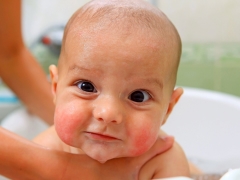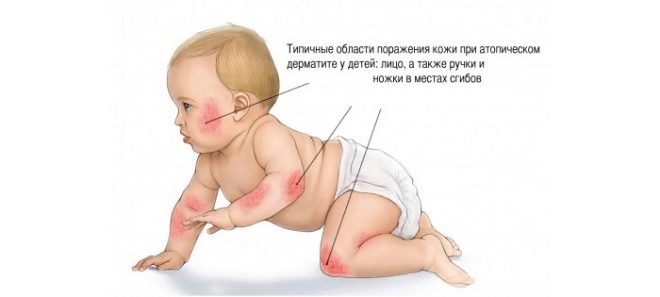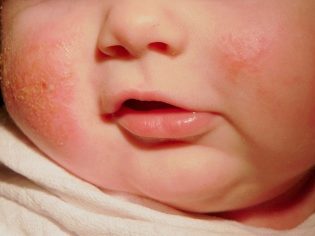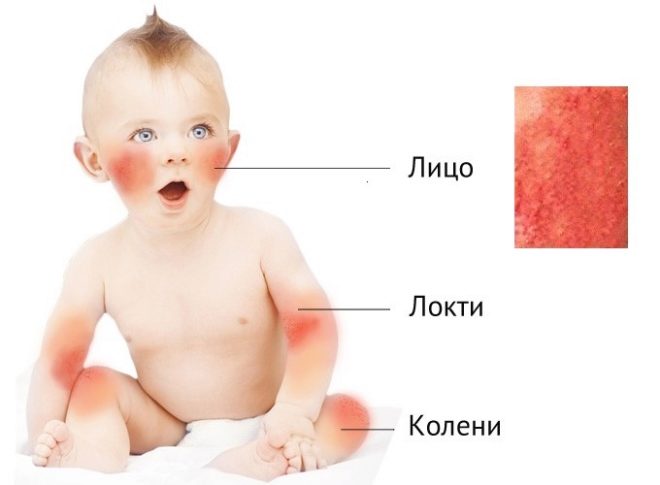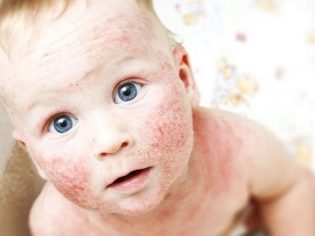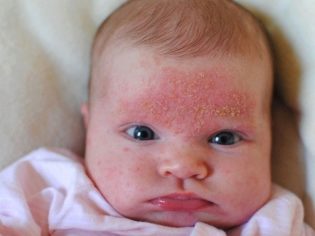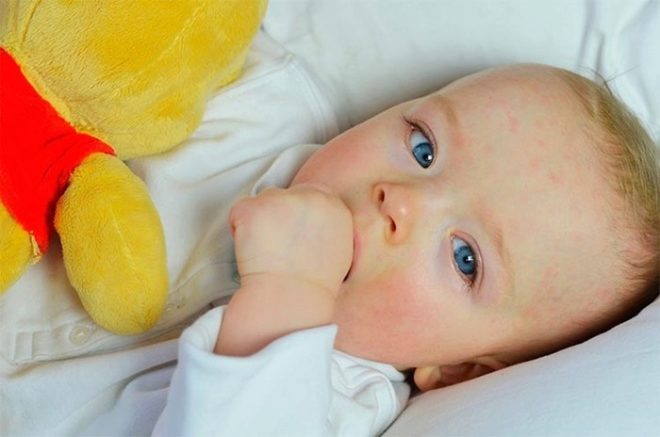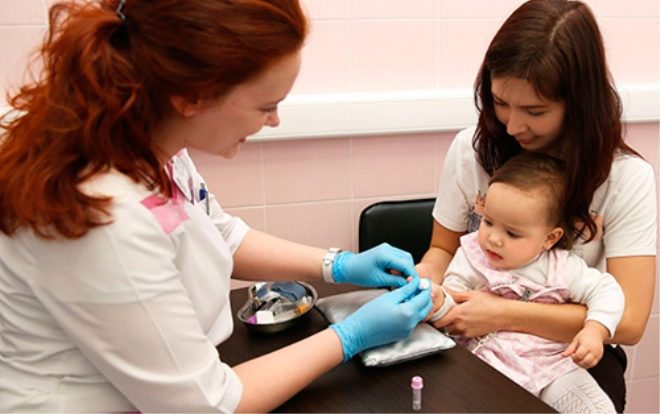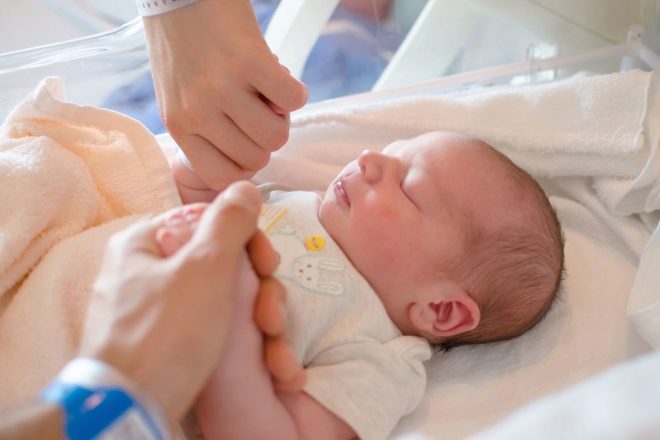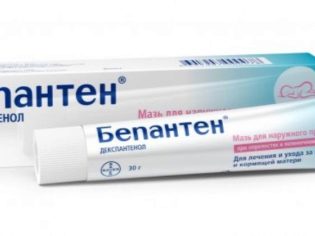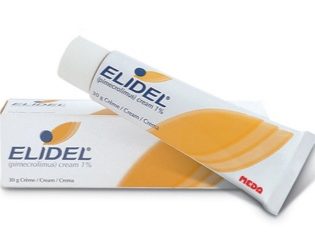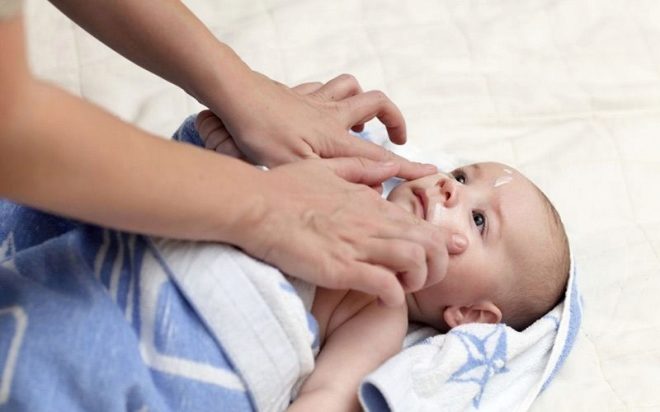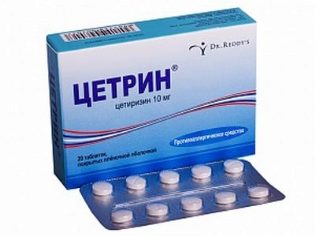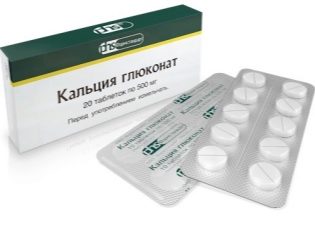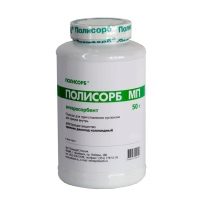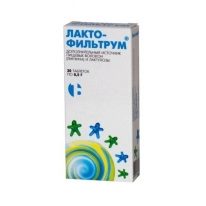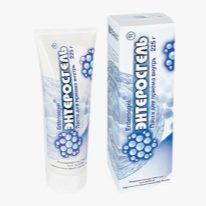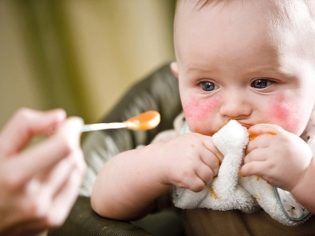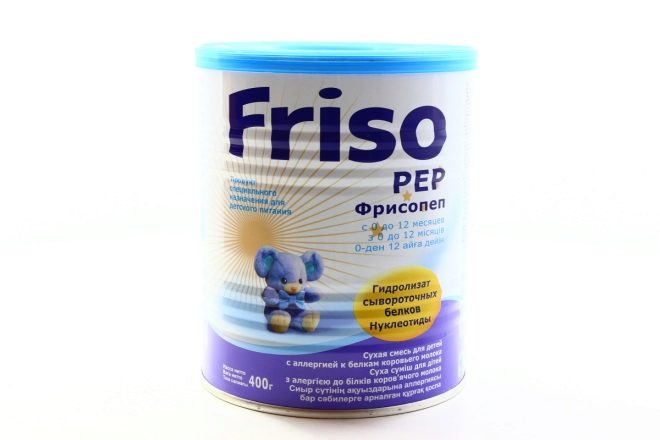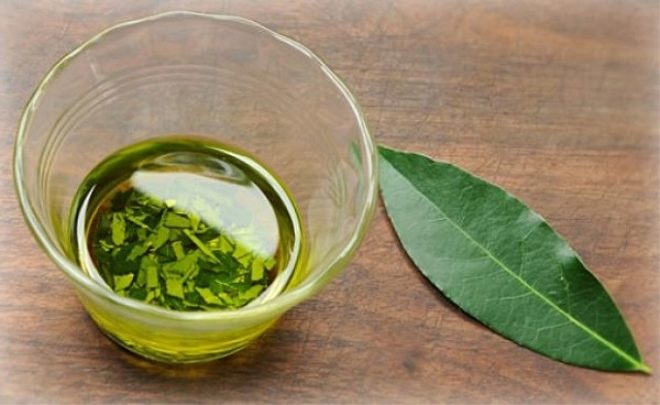Atopic dermatitis in infants
Atopic dermatitis is quite common in children under 5 years old. For the first time the disease can debut from the first days after birth. The course of the disease in nursing babies has a slightly different character than in older children. Treatment of babies in the first year of life requires a softer approach, without the use of strong drugs.
What it is?
In atopic dermatitis, systemic inflammation occurs in response to an allergen provoking factor entering the body. Often, babies with similar diseases have a certain genetic predisposition. If a child has both parents allergic, then in 80-90% of cases he may have signs of atopy. If only dad or mom have allergic reactions, then the probability of inheritance of the trait is 40%.
Causes of newborns and infants
Researchers have not come to a unanimous opinion about the cause of the disease. They found that several provoking factors can influence the development of the disease. It is impossible to predict how the child’s body will react to the ingress of an allergen. It directly depends on the individual sensitivity and peculiarities of the baby’s immune system.
Several factors can influence the development of the disease:
Genetic predisposition to the development of atopic dermatitis. Several polymorphic genes are considered to be immediately responsible for hypersensitivity to various provoking agents. They are responsible for the functioning of the immune system and the recognition of foreign substances by the body. Close relatives in families suffering from atopy have an identical set of genes.
Reduced immunity. As a rule, it can be a congenital or acquired immunodeficiency. In such situations, the ingress of any antigen into the body in the presence of an individual predisposition can cause a violent response.
Chronic diseases of the digestive system. It is noted that in children suffering from pathologies of the gastrointestinal tract, the risk of developing atopic dermatitis increases many times. In newborns, these pathologies are often congenital. Atresia of the cardia or disruption of the structure of organs can lead to disruption of the normal functioning of the digestive system. This condition also leads to changes in the intestinal microflora, and hence the depression of immunity.
Manifestations of dermatitis after the introduction of complementary foods. Often, the first skin problems begin to occur in babies after adding new foods to the diet. Breast milk idiosyncrasy does not happen. In composition, it is an excellent and complete protein product. Breast milk is 99.8% absorbed by the child's body. With the introduction of mixtures in the baby may experience allergies and atopic dermatitis.
In more rare cases, house dust or household mites can be a provoking factor. These tiny microorganisms live in pillows and bedding. In summer and hot time, their number may increase several times. Getting on the delicate skin of the baby, they can easily cause a strong allergic reaction and provoke the appearance of atopic dermatitis.
Direct contact with chemicals. Often such provoking factors are hygiene products or household chemicals. Babies may experience contact atopic dermatitis on clothing. As a rule, the cause of such a reaction is an allergic reaction to the components of the laundry detergent. Wearing diapers also often provokes this type of dermatitis.
Parasitic invasions. They are found in babies closer to the year. At this time, mommies begin to give the kids as a complementary food fresh fruits and berries. Inadequate hygienic treatment can lead to infection of the child with various worms. Settling in the intestines, they release dangerous toxins. These substances can be a provoking factor for the onset of an allergic reaction. Parasitic diseases, as a source of atopic dermatitis, are found in pediatric practice quite often.
Main symptoms
Atopic dermatitis may manifest itself in different ways.. The severity of clinical signs will depend on the severity of the disease. The development of the disease can be divided into several stages:
initial stage
During this period, the disease is manifested by the appearance of various red spots or hyperemia. More often with contact forms of dermatitis, they appear at the places of contact with clothing. Diffuse forms are characterized by the spread of spots throughout the body. A large number of bright redness is noted on the back of the neck, cheeks, in the places of the elbow pits and under the knees.
Acute illness
At this time, the baby looks very painful. Severe itching joins skin manifestations. Kids begin to comb damaged skin. With a severe course of the disease, oozing wounds begin to form. Multiple papules or vesicles with serous contents may appear on certain parts of the body. The skin on the affected areas becomes hot, red. Violated the general condition of the baby. He becomes more sluggish, capricious. May refuse to chest. Kids do not sleep well due to severe itching. At night, the condition improves somewhat.
Period of subsidence of the inflammatory process and the onset of remission
At this time, all the bright symptoms of allergy disappear and are replaced by new skin manifestations. In place of weeping wounds appear crusts. The skin becomes thickened, changing its architecture and structure.
With a long course of the disease and long-term use of hormonal drugs, areas with thinner skin may form. In place of scratching remain, as a rule, thin white or red stripes.
The skin pattern changes somewhat, it becomes more dense and rough. Some babies have pronounced flaking on the scalp. The skin becomes drier and requires constant hydration.
In order to properly prescribe treatment, additional diagnostics are required. The elimination of the provoking factor is an important therapeutic procedure in the treatment of atopic dermatitis. Even despite the treatment, without eliminating the action of the allergen, it is often not possible to achieve complete remission.
Diagnostics
Usually, the appointment of additional examinations makes the allergist-immunologist. If the child has the first signs of the disease, you should definitely show it to a specialist. Newly detected atopic dermatitis requires mandatory additional research.
General blood analysis
Allows you to accurately and quickly establish the allergic form of the disease, as well as to distinguish atopic dermatitis from various infectious diseases. A marked increase in the level of leukocytes and eosinophils indicates an allergic reaction. Virtually all variants of atopic dermatitis occur with accelerated ESR.
In the midst of the acute stage of the disease, there may be a slight increase in lymphocyte levels. This indicates the activation of cellular immunity and the beginning of an allergic reaction. Also, the leukocyte indicators will tell the doctor whether the secondary bacterial infection or the complications of the disease have joined.
Provocative allergy tests
They are not informative in infants toddlers. Studies with the scarification tests are recommended for use only in children from the age of three. Performing such studies in babies of infancy is not informative and does not give an accurate and reliable result. It is also very difficult to technically perform a scarification test in a toddler. An alternative to this research is serological testing.
Determination of specific antibodies
It is used in children with severe disease. Usually, such tests are recommended by doctors in older children. However, with frequent exacerbations of the disease, when clarification of the allergen is required, serological studies are also used in infants. The analyzed material for analysis - venous blood. When performing this laboratory study, you can check several groups of allergens. The analysis period is usually 3-4 days.
With the help of such a test, the doctor can give the most accurate recommendations on what provoking factors cause manifestations of atopic dermatitis in a baby. This study also identifies all cross-allergens. A significant disadvantage of this analysis is the high cost. For each group of allergens will need to pay about 5,000 rubles.
Treatment
Today, for the treatment of atopic dermatitis is used quite a lot of different medicinal substances. Many of them are applied topically to damaged skin. With a more complicated course of the disease - drugs are prescribed in the form of injections or tablets. The course of treatment for atopic dermatitis is usually long. Medications can be prescribed from 10 days to several months.
Local treatment
For these purposes, use various ointments, creams or suspensions that have anti-inflammatory action. For dry skin, preference is given to oily creams or ointments. Such dosage forms perfectly penetrate into all layers of the skin and can effectively eliminate inflammation.
Among the most frequently used means - anti-inflammatory. These include: "Bepanten", Zinc ointment,"Elidel"," Emolium ", as well as many others. These drugs help not only to eliminate inflammation, but also have a positive effect on the skin. For example, zinc ointment has a drying effect. It can be applied on weeping damage.
The use of hormonal ointments helps to quickly cure disease exacerbations. The basis of such drugs, as a rule, contains prednisone or beclamethasone. You should not be afraid of side systemic actions of such drugs! The content of the acting form of hormones in them is minimal. They cannot trigger a pronounced systemic effect.
It is better to use hormonal ointments only after consulting a pediatrician as there are certain contraindications for use for a number of drugs.
Systemic drug use
Prescription drugs for the treatment of atopic dermatitis in infants is carried out taking into account the adverse symptoms of the disease.Typically, treatment is carried out in a complex with the use of different groups of drugs. To eliminate the pronounced itch babies are prescribed antihistamines. These include: "Zyrtec", "Fenistil", "Tsetrin" and many others. Also, calcium gluconate will help to reduce intolerable itching and calm the baby. The use of this drug does not cause adverse reactions and is well tolerated by the child's body.
To eliminate toxins and biologically active substances, which are formed in the process of allergic inflammation, various enterosorbents are widely used. The safest and most effective: "Polysorb», «Lactofiltrum», «Enterosgel". Reviews after the use of such drugs are usually the most positive. Through the use of these sorbents, the disease passes in a shorter time.
Various preparations enriched with lacto - and bifidobacteria are used to normalize the intestinal microflora. Usually they are prescribed after the course of sorbent administration. Probiotics that are part of these drugs, have a stimulating effect on the growth of beneficial microflora in the intestine. It is worth to use such medicines for a long time, for a month. Repeat courses should be 2 times a year.
For babies who have developed atopic dermatitis after the introduction of new foods, the diet should be changed. The best choice will be hypoallergenic mixtures. Their composition is selected in such a way that all substances with strong allergenic properties are completely excluded. Kids, getting such food, feel great. Their intestinal function is normalized, their immunity is restored and all unfavorable skin rashes pass.
For babies of the first year of life, you can pick up various nutritional ready-made mixtures with low allergenic properties. In the nutrition "Frisopep" there are no components of cow's milk. For babies with lactase deficiency or intolerance to bovine protein, such a product will be an excellent choice for the preparation of a diet. This nutrient mixture can be used from the first days after the birth of the baby. It is also perfect for premature babies or babies with low weight.
What is used for home treatment?
To eliminate the adverse symptoms of atopic dermatitis, mothers often use various means of traditional medicine. In such cases, you need to figure out which of these methods will not harm the baby.
The skin of a newborn baby is very sensitive. Any exposure to aggressive chemicals can cause severe irritation. In case of individual predisposition to atopic dermatitis, such contact with a substance can cause exacerbation of the disease.
Therefore, to eliminate the adverse symptoms characteristic of allergic skin diseases, you can use medicinal plants or products that are not strong allergens at home.
Bay leaf has antiseptic properties. Cooked weak broth from this plant can be added to the bath when bathing. This will protect the baby’s tender skin from possible bacterial infection. Before carrying out such bathing - be sure to check the reaction of the baby.
To do this, spend a diluted decoction of bay leaf on the skin of a child. Evaluate the reaction in 10-15 minutes. If the skin is clean and there is no irritation, you can safely use this broth. Check the reaction on the baby's skin in this way every time you use a new product. Note in the diary all the negative effects after the use of different tools. This will reveal many of the possible factors causing the aggravation of the disease.
Preparations containing aloe juice are good anti-inflammatory drugs. Try to choose such products, which are marked with a label that allows the use of these substances from the first days after birth. Aloe has excellent antiseptic properties, and also contributes to the speedy regeneration and restoration of the skin after severe inflammation. Such means are applied, as a rule, by a course of 14 days.
After subsiding, inflammatory lesions on the skin very often remain dense crusts or scales. They are poorly removed and exfoliated. To soften the skin, use sea buckthorn oil.. It will help moisturize and nourish all skin layers. When using this oil, the skin becomes more hydrated, all crusts disappear. You can also apply this product to the place of scratching. It will help restore the skin structure and reduce scarring somewhat.
For babies whose atopic dermatitis develops as a result of cow protein intolerance, you can use goat milk. It should be added to various cereals, mashed puree. It can also be mixed into various hypoallergenic mixtures to obtain a uniform consistency. Goat milk is an excellent choice for babies with lactose intolerance. On the basis of such a product a variety of yoghurts, cheeses and other dairy products are made. It perfectly nourishes the children's body with protein and promotes active growth.
Prevention
Reducing the risk of developing aggravations of atopic dermatitis will help daily adherence to preventive measures. Follow these rules from the first days after the birth of the baby. If a family of someone from close relatives had manifestations of atopic dermatitis, then prevention should be carried out necessarily.
To prevent exacerbations of atopic dermatitis, you should:
Try, as long as possible, to maintain breastfeeding.. Mother's milk is the most hypoallergenic product for any child. This beautiful natural food product is absorbed by a child's body by 99.8%. Usually, the first manifestations of atopic dermatitis begin to occur when breastfeeding is discontinued or when switching to various adapted mixtures. Prolonged lactation is the key to the baby’s well-being and the formation of full immunity.
Treatment of exacerbations of other chronic diseases. Any infections in babies - infants must be identified and treated. Especially in the pathology of the gastrointestinal tract. Delayed treatment can lead to pronounced dysfunction of the internal organs and, as a consequence, reduced immunity. Acquired secondary immunodeficiencies may appear in long-term ill children. Such conditions often provoke the appearance of any allergic reactions.
Strengthening immunity. Proper functioning of the immune system allows you to avoid various overly acute inflammatory reactions. Active walks in the fresh air help the baby to strengthen the immune system. In the warm season, overly wrapping a newborn or infant is not worth it. A little hardening will be a great way to boost your immune system. Choose clothes for the weather.
Introduction as a lure hypoallergenic products. As a rule, doctors are advised to introduce the first new products in green or white colors. Perfect fit: cauliflower, broccoli or zucchini. These products are practically unable to cause dangerous allergic reactions in babies - babies. For children who have already been diagnosed with atopic dermatitis, adherence to a hypoallergenic diet is required regularly throughout their lives.
Severe adverse symptoms of an allergic disease in infants can cause real shock in parents. Do not panic! Currently, atopic dermatitis is well diagnosed and treated.
A huge arsenal of medicines allows you to quickly eliminate all the adverse symptoms of the disease, which bring pronounced discomfort to the baby. Comprehensive treatment of the disease and adherence to the hypoallergenic diet will allow the baby to be practically healthy and active.
How to treat atopic dermatitis in an infant see in the program of Dr. Komarovsky
